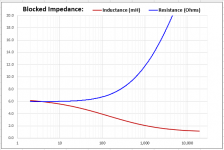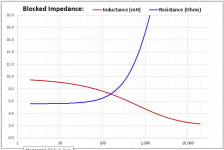The basic Bl force "ratio" cannot be discarted just like that, as in 30-60Hz range, the inductance is low. Also 21DS115 is stronger than 21SW152.
The 21DS115 is not stronger than the 21SW152, you cannot apply the same raw BL^2/Re formula to both drivers for the purpose of comparisons (unless you want misleading results) since one driver has a high relative inductance and the other doesn't .. .. Apples to oranges ..
Inductance is also not low in the 30hz to 60hz range .... Inductance increases when you go lower in frequency on the same voicecoil, meaning a voicecoil that has 2mh of inductance at 1000hz will have much more inductance by the time we get down to 60hz, and that slope isn't fixed, it becomes more steep with drivers that have high relative inductance (When i say "relative" I am referring to how the inductance relates to the coil's DC resistance or "Re") ..
Last edited:
Is there any math available on this? Right now it sounds like nonsense to me, but I still can be mistaken. Ad absurdum, you would have most inductance at DC voltage, which cannot be true. (Bl * Bl) /Re might not be good for precise evaluation, but it is still valid and most significant chunk in the equation. Rooted number should give you newton force per watt. So better number actually means it is stronger... It is not wrong at all, it might just be imprecise because of not counting for other variables.
See attached. The red line shows how the inductance of the 21SW152 varies with frequency (based on extracted impedance data from its published impedance curve).
Good find Brian!

I am going to save that graphic .... I have been trying to find more good examples of inductance curves ...
Once the manufacturer publishes an impedance curve, it's not that difficult to use a tracer to generate a ZMA file from that curve, and then the semi-inductance spreadsheet can be used with that data to generate the inductance curve.
I have come across one example of where the spreadsheet fails to do that though, and I've raised that issue with its creator on the relevant thread
I have come across one example of where the spreadsheet fails to do that though, and I've raised that issue with its creator on the relevant thread
Is there any math available on this? Right now it sounds like nonsense to me, but I still can be mistaken.
... it might just be imprecise because of not counting for other variables.
Crashpc,
Folks like Brian and Just A Guy have been talking about it and helping to develop tools to help our software better interpret inductance and motor force ........ I have been told that going back even further Leach and Wright addressed the Lossy Inductance and Complex Inductance or whatever terms they used for it but i haven't yet even attempted to delve into that ..
A while back Just A Guy from DIYaudio and some of his associates wrote a paper called "Large Coil Simulation Accuracy Issue and Adjustment" describing the modeling error caused by our software's misinterpretation of drivers with high relative inductance (like the DS115 series) and then came up with a formula which derates the BL of a driver to a degree based upon how high a driver's relative inductance is in order to achieve a more accurate model .....The amount of adjustment was averaged from multiple real world measurements ... .... The formula was since integrated into Hornresp as the "Lossy Inductance" feature which can be enabled when modeling subwoofer range designs around drivers that have high relative inductance (otherwise you can leave the feature disabled) .. .... It is not perfect but it definitely does help to correct and increase the accuracy of our Hornresp models when using these sorts of drivers..
Brian (and team?) has since taken things a step further by developing the Semi-Inductance method which is more versatile and improves accuracy with more than just subwoofer models and not just specifically drivers with high relative inductance . .
Last edited:
To be clear I am not discarting existence or importance of these effects, but what I saw so far from googling the issue, there are some details missed, and different parameters/aspects are discussed, which might be more of the reason for disagreement. I'll go play with hornresp to dig some new data for me, and compare...
Okay, came from Hornresp sims. I did not input favourable parameters for 21DS115 against 21SW152 at all. The "measureable difference" only ocurs from 85 Hz up, within 1db still at 100Hz.
The 21DS115 still wins over 21SW152 on sensitivity, motor force and efficiency. (Bassreflex box 160l @ 30Hz). I cannot see any opposite data at this moment.
The 21DS115 still wins over 21SW152 on sensitivity, motor force and efficiency. (Bassreflex box 160l @ 30Hz). I cannot see any opposite data at this moment.
Okay, came from Hornresp sims. I did not input favourable parameters for 21DS115 against 21SW152 at all. The "measureable difference" only ocurs from 85 Hz up, within 1db still at 100Hz.
The 21DS115 still wins over 21SW152 on sensitivity, motor force and efficiency. (Bassreflex box 160l @ 30Hz). I cannot see any opposite data at this moment.
Did you use semi-inductance parameters in your sim?
Brian (and team?) has since taken things a step further by developing the Semi-Inductance method (snip)
I certainly didn't develop it, LOL. Guys with a lot more working brain-cells than I have did that
More info here: The Subwoofer DIY Page - Semi-Inductance
See attached. The red line shows how the inductance of the 21SW152 varies with frequency (based on extracted impedance data from its published impedance curve).
..and here's the curve for the 21DS115. The inductance is significantly higher than that of the 21SW152 at lower frequencies.
Attachments
Brian Steele: Yes. I used semi inductance parameters. Compared 21DS115 with 21SW152. 21DS115 was affected more, but basically, it didn´t do much to the simulation, which would push one to consider that 21DS115 is less efficient or has weaker motor.
I certainly do not disagree on the presence of inductance. But its effects on efficiency are not significant enough. Or at the moment it seem to not be the case.
I certainly do not disagree on the presence of inductance. But its effects on efficiency are not significant enough. Or at the moment it seem to not be the case.
I certainly didn't develop it, LOL. Guys with a lot more working brain-cells than I have did that. Knud Thorborg and Claus Futtrup wrote the paper, and Stephen Bolser (who has a thread going here on the subject) developed a spreadsheet that can be used to derive the parameters.
More info here: The Subwoofer DIY Page - Semi-Inductance
Correct...This goes way back many many years. Thankfully with Bolserst's hard work on the spreadsheet, David's inclusion into HR of the semi-inductance model and modern measurement gear or curve fitting apps, we now have free tools available and useful for the hobbyist DIYer.
Note this is a much different thing than the lossy inductance check box in HR that was developed a few years ago as a generic approximation for any driver. This was better than nothing but using the derived semi inductance specs is far more accurate. Also there is no cut-off point where a driver should use the lossy Le function and another should not, like I saw suggested earlier. The driver that is the subject of this thread has a shorting ring employed and there is nothing in the specs or impedance curve that suggests the inductance is significantly different than other drivers with similar specs. If in doubt use the spreadsheet and a derived impedance curve to do a HR comparison. It's not a clone of another driver either.
Also comparing drivers based on inductance / semi inductance alone as a modifier of motor force isn't very useful. Doesn't matter whether it's from Bolserst's spreadsheet or not. Actually motor force compared in a vacuum isn't very useful either.
Sorry about that, my mistake ....
Brian has done such a great job with other useful spreadsheets that i thought he might have had a part in this one too ..
I need to read more about the semi-inductance method..... Currently i am only just familiar with the "Lossy Le" feature/formula and what it implies about how relative inductance can influence real world motor force ..
Brian has done such a great job with other useful spreadsheets that i thought he might have had a part in this one too ..
I need to read more about the semi-inductance method..... Currently i am only just familiar with the "Lossy Le" feature/formula and what it implies about how relative inductance can influence real world motor force ..
- Status
- This old topic is closed. If you want to reopen this topic, contact a moderator using the "Report Post" button.
- Home
- Loudspeakers
- Subwoofers
- B&C 21SW152 clone

